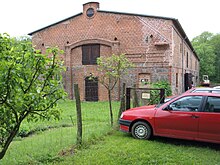International Bat Museum Julianenhof
The International Bat Museum Julianenhof is a natural history museum in Julianenhof, part of the municipality of Märkische Höhe in the Märkisch-Oderland district , which is committed to protecting bats and their environment. The museum shows visitors the life of animals and comprehensively documents the development of their research. NABU is responsible for the museum . There is currently no other museum of this type in Germany.
building
The museum is located in the Märkische Schweiz nature park between Berlin and the Polish border. Today's Julianenhof was built in 1855 as a preliminary work for the Reichenberg estate; the building of today's bat museum was used as a stable during the GDR era . After the NABU - Regionalverband Strausberg-Märkische Schweiz eV acquired the 9500 square meter site with funding , the buildings were almost restored to their original condition with the financial support of the Brandenburg Nature Protection Fund . Extensions were demolished and the main building restored. The outdoor area "Naturerlebnis Bat" was completed in 2010/2011.
The ice cellar on the site is one of the largest in Brandenburg with a ceiling height of over five meters and a floor area of almost 40 square meters . Its volume once made it possible to store around 120 cubic meters of ice, which could last for up to two years thanks to the 1.85 meter thick outer walls with air chambers. Today bats hibernate in this building. The ice cellar was reconstructed in 2000 with funding from the state of Brandenburg.
The small bat garden was created in 2008. It should give suggestions and tips for your own garden. The beds are dedicated to different groups of insects that serve as food for our native bats.
A collection of different types of bat boxes is presented outside and inside the museum .
tasks and goals
According to the Agreement on the Conservation of European Bat Populations, 31 European countries have committed to protecting the population of bats. The museum makes its contribution to this agreement and informs visitors in a permanent exhibition. There are changing special exhibits, guided tours and lectures take place. Information, education and research are combined here. Visitors learn suitable measures to protect the bats and their habitat. The aim of the museum is to become a communicative hub for national and international bat researchers and conservationists.
successes
Under the roof structure of the museum are the nurseries of the great bearded bat, the rough-skin bat, the pipistrelle bat and the mosquito bat. According to the excursion count on June 2, 2017, the population of these species has increased to 1282 animals.
So far have been Natterer's bat , Daubenton's bat , Barbastelle , Serotine , Brandt's bat, brown long-eared , Gray long-eared , greater mouse-eared , the pipistrelle , the Pipistrelle , the mosquito bat and the Bechstein's bat in different quarters steps of the museum area detected.
Finances
The museum does not receive any financial support for its permanent operation. Since admission is free for visitors, one is dependent on donations for the maintenance and further expansion of the museum.
Web links
- Official website of the International Bat Museum Julianenhof
- International Bat Museum Julianenhof . In: Brandenburg.Nabu.de
- International Bat Museum Julianenhof . In: Berlin.de
Individual evidence
- ↑ Expansion and renovation on the museum website. (Retrieved January 18, 2012.)
Coordinates: 52 ° 35 ′ 15.6 " N , 14 ° 7 ′ 7.4" E


